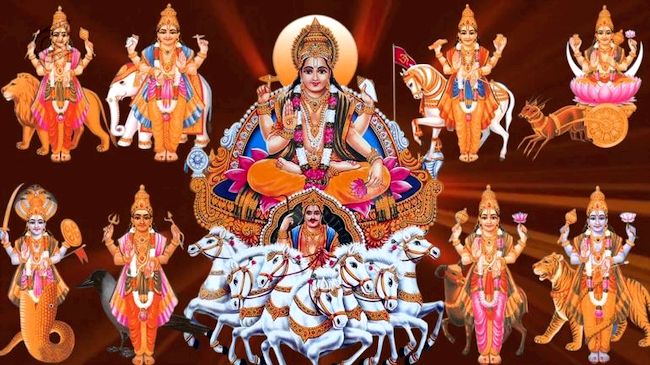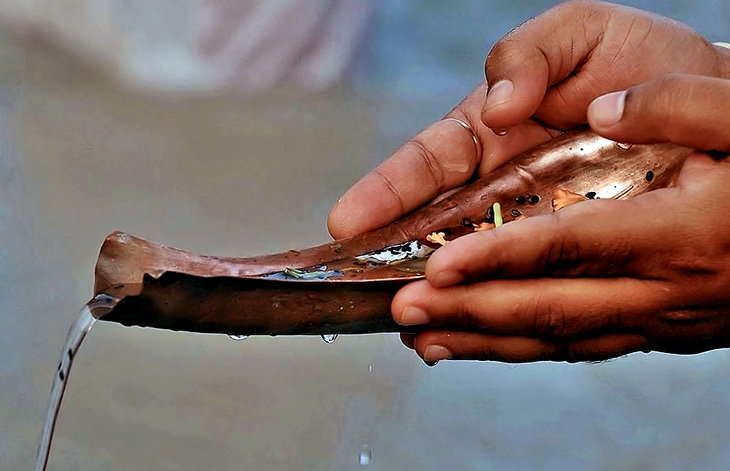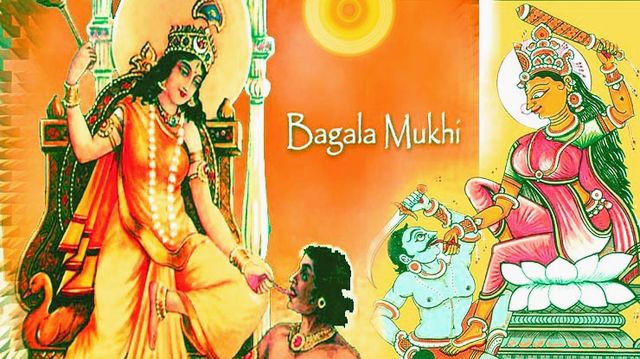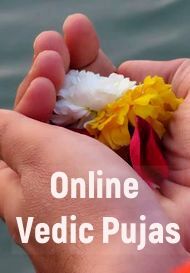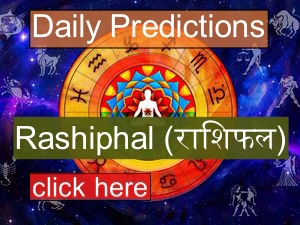Navaratri – The celebration of the nine forms of Shakti

The Adi Shakti – the beginning of everything and to honor the Goddess Shakti Hindus worship various forms of Durga for 9 days during Navaratri. A celebration of the power that is the woman, the part of everyone that is feminine, that is nurturing and divine.
Adi Shakti
The most widely accepted account of the nine forms of Durga is the one found in the Devi Mahatmya – Shailaputri, Brahmacharini, Chandraghanta, Kushmanda, Skanda Mata, Katyayani, Kalaratri, Maha Gowri and Siddhidayini.
‘Navratri’ in Sanskrit translates to ‘nine nights’. It occurs in the post-monsoon autumn festival called Sharad Navratri that is the most observed in the honor of the divine feminine Devi (Durga). The festival is celebrated in the bright half of the Hindu calendar month Ashwin, which typically falls in the Gregorian months of September and October.
Navratri is separated into sets of three days in which First three days of Navratri are dedicated to Goddess Durga, the Goddess of power and energy. Next three days of Navratri are dedicated to Goddess Lakshmi, the Goddess of wealth and prosperity. The final three days belong to Goddess Saraswati who is worshipped to acquire the spiritual knowledge.
Origin of Devi Shailaputri
Shailaputri means daughter (Putri) of the mountain (Shaila). Goddess Durga is named Shailputri, as she was born in the house of the King of Mountains “Parvat Raj Himalaya”. Among the nine Durga forms, Shailputri is the first and foremost one.
In her previous birth, it was said that Shailputri was Sati, daughter of Daksha. Once Daksha performed a big Yagna without inviting Shiva. But Sati, wife of Shiva, came there with Lord Shiva. Daksha insulted Shiva. Sati could not tolerate this and she burnt herself in the fire of Yagna. In another birth, she became the daughter of Himalaya and got married to Shiva as Hemavati.
She is Devi of the root chakra, who, upon awakening, begins her journey upwards. Sitting on Nandi and making her first journey from the Muladhara chakra. As from her father to her husband – the awakening Shakti, beginning her search for Lord Shiva or making a move towards her Shiva. So that, In Navratri pooja the first day Yogi’s keep their mind concentrated on Muladhara. This is the starting point of their spiritual discipline. They started their Yogasadha from here. Shailaputri is the Muladhara Shakti to be realized within self and sought for higher depths, in the yogic meditation.
Governing Planet
It is believed that the Moon, the provider of all fortunes, is governed by Goddess Shailputri and any bad effect of the Moon can be overcome by worshipping this form of Adi Shakti.
The mount of Goddess Shailputri is bull and because of that, she is also known as Vrisharudha (वृषारूढ़ा). She carries Trishul in the right hand and the lotus flower in the left hand. A half-moon decorates her forehead. Goddess Shailaputri symbolizes the power of Brahma, Vishnu, and Shiva.
Puja
On this day fast is observed and puri and Ghee is offered on the foot of Mother. This also blesses the devotee with a disease-free life.
The ritual starts with the Ghatasthapana where Goddess Shailputri is worshiped with flowers, rice, roti, and sandalwood. Also, a Kalash is filled with 7 kinds of soil (Saptmritika), clay, nut and five kinds of coins. Below this Kalash, 7 kinds of grains and barley seeds are sown, that are harvested on the tenth day. These crops are then offered to all gods and goddesses. In Nepal, Jamara- the sapling is distributed as prasad along with tika from the elders to the young ones as blessings. Red is considered as an auspicious color for devotees on this day
Main temples of Maa Shailputri
Maa Shaileshwari temple at Mariya Ghat, Varanasi.
“Naddi” is a tourist spot near Dharamsala in Himachal Pradesh
Prarthana
वन्दे वाञ्छितलाभाय चन्द्रार्धकृतशेखराम्।
वृषारूढां शूलधरां शैलपुत्रीं यशस्विनीम्॥
Vande Vanchhitalabhaya Chandrardhakritashekharam।
Vrisharudham Shuladharam Shailaputrim Yashasvinim॥
Meaning: Worshipping Goddess Durga in the Maa Shailputri form will help in overcoming any bad effect of the moon, which is governed by this form of Adi Shakti.
Devi Brahmacharini
Devi Brahmacharini symbolizes peace, happiness, devotion, and determination.
Origin of Devi Brahmacharini
She’s considered as an unmarried mediating form of Goddess Parvati, who desired to marry Lord Shiva. The name Brahmacharini means the person who penances. Her constant penance for more than thousand years pleased Lord Shiva. First, she survived on fruits and then on dried Bilva leaves. Later, she quit food and dedicated all the time to prayer. This forced Lord Brahma to grant her wish to marry Lord Shiva.
Worshiping this form of Shakti is known to invoke the spirit of penance, renunciation, virtue, and nobility. She used to live in mountains like Shiva, engage in the same activities as Shiva, one of asceticism, yogin and tapas – it is this aspect of Parvati that is deemed to be that of goddess Brahmacharini. She is also known as Tapasyacharini.
Devi Brahmacharini wears white clothes holds a Japa Mala (rosary) in her right hand and Kamandal, a water utensil in her left hand. She is depicted as a monastic goddess in Hindu scriptures, two-armed, clad in white and holding a rudraksha mala and a sacred Kamandalu.
Governing Planet
It is believed that Lord Mangal, the provider of all fortunes, is governed by Goddess Brahmacharini.
Puja
Sugar is offered to the Goddess on the second day. It is said that by offering sugar, the longevity of the family members increases. It is often seen that people wear clothes of blue color while offering their poojas.
Temples to visit
Brahmacharini Temple, Varanasi
Prarthana
दधाना कर पद्माभ्यामक्षमाला कमण्डलू।
देवी प्रसीदतु मयि ब्रह्मचारिण्यनुत्तमा॥
Dadhana Kara Padmabhyamakshamala Kamandalu।
Devi Prasidatu Mayi Brahmacharinyanuttama॥
Devi Chandraghanta
It means “one who has a half-moon shaped like a bell”. She is also known as Chandraghanta, Chandika or Rannchandi.
Origin of Devi Chandraghanta
According to legends, when Sati burned her body in the Yagya Agni, she took rebirth as Parvati to Parvatraj Himalaya. Parvati married Lord Shiva. On the day of their marriage, Lord Shiva arrived with all his Aghoris and Ghosts to take Devi Parvati along with him. On seeing this form of Shiva, her parents and all the guests were horrified.
Looking at all this, Parvati transformed herself into Goddess Chandraghanta – ten hands, golden complexion, kamandalu, mace, arrow, lotus, sword, mounted on her lion as she approached Lord Shiva. She requested him to reappear in the form of a charming prince. In the meantime, she revived her family from the shock and erased all their unpleasant memories. Since then, Devi Parvati is worshiped in her Chandraghanta avatar as the goddess of peace and forgiveness.
Governing Planet
It is believed that the planet Shukra is governed by Goddess Chandraghanta.
She is depicted as a fierce 10-armed Goddess, roaring in anger. She has a golden complexion and on her forehead, she wears a crescent moon, which is why she is called Chandraghanta. She is shown with 10 hands- left hand she carries Gadha, sword, Trishul, and Kamandalu and on her right- arrow, Dhanush, Japamala. Her fifth left hand is in Varada Mudra and her fifth right hand is in Abhaya Mudra.
Puja
The Goddess is pleased by offering milk, sweets or kheer. This ritual ends with the worship of Lord Shiva and Brahma. On this day, it’s good for devotees to wear something in a yellow color while performing the rituals and pooja. Though the Goddess herself drapes a white saree, which symbolizes peace and forgiveness, it is said that her worshipers should wear yellow throughout the day.
Chandraghanta Mantra
Ya devi Sarvabhooteshu, Maa Chandraghanta Rupen Sansthita |
Namastasyai Namastasyai Namastasyai, Namo Namah||
Pindah Pravarudha Chandkopastrakayurta |
Prasand Tnute Mahayam, Chandraghanteti Vishruta ||
Meaning: “I join my hands in front of the powerful Goddess, one with the bell-shaped moon on her forehead. I worship her to forgive all of my bad deeds.”
Kushmanda Devi
Her name means the cosmic egg- The name Kushmanda is made of three other words ‘Ku’ (little), ‘Ushma’ (warmth or energy) and ‘Amnda’ (egg) which means the one who created the universe as the “Little Cosmic Egg” with energy and warmth.
Origin of Kushmanda Devi
According to Hindu scriptures, the universe was a dark space and it was Goddess Kushmanda who produced the Cosmic Egg with her smile. She created the world from nothing. Kushmanda Devi represents the Anahata chakra in yogic terms. She takes away all sorrows and troubles from the life of her devotees and blesses them with good health, mental peace, and prosperity. It is said Goddess Parvati started residing in the Sun to ensure that he releases the power to the Universe. She radiates the fire and energy of the Sun she resides in.
It is said that she first created Mahalaxmi from her center eye, from left- Mahakali and Saraswati from right eye.
It is also believed that this is the only goddess who can bestow 8 siddhis (perfections) and 9 nidhis (jewels) to her saadhaks.
Kushmanda Devi is depicted with eight hands. She has kamandal, dhanush, bada and Kamal in the right hands whereas, she is holding an Amrit-Kalash, Japa-mala, gada, and chakra in her left hands. Her beautiful female form is seen sitting on a lion that denotes dharma and justice.
Governing Planet
It is believed that Goddess Kushmanda provides direction and energy to the Sun. Hence God Sun is governed by Goddess Kushmanda.
Puja
Several strotram path, kawach and aartis are performed during Kushmanda Devi’s Puja. Devotees keep flowers in their hands to offer to this goddess. This offering is called Naivedhya or Naibidhya. Malpuwa is offered to the goddess. According to Shastras and puranas, Lord Shiva and Brahma must be worshiped after the Kushmanda Puja. Devotees adorn the color ‘Green’ for the fourth day.
Kushmanda Devi Mantra
Ya devi sarvabhuteshu ma kushmanda
rupen sansthita namastaseya namastaseya
namastaseya namoh namah
Meaning: “Goddess Kushmanda, who holds two pitchers full of wine and blood in her lotus hands, is propitious to me.
Devi Skandamata
Skandamata or the mother of Kumar Skanda is worshipped on the fifth day of Navratri. As a symbol of fertility, motherhood, mother-child relationships and endurance.
Origin of Devi Skandamata
According to Hindu mythology, when all devtas (deities), manushya (mankind) and rishis (sages) were tired by the atrocities of demon Tarkasur, they sought help from Brahma to help end this demon’s tyranny. Brahma, who was earlier pleased by the hard penance of Tarkasur, granted him with the boon of invincibility from all, except Lord Shiva’s son. Upon being urged by all the devtas, Lord Shiva agreed and got married to Parvati, the daughter of Himalaya and later, their son Skanda destroyed the demon. Skanda is another name for war god Kartikeya.
The energy of Shiva and Parvati formed a fiery ball and Lord Agni was entrusted to carry the energy to lake Sarvana till the ball became Shiva’s offspring. Even Agni couldn’t bear the heat and handed it over to Ganga. Parvati alone was able to seed such energy and took a form of the water body, Thus Kartikeya was born with six faces and raised by six Kritikaas, hence the name. Being the mother of such a valiant son, Goddess Parvati came to be known as Skandamata.
It is believed that she awards devotees with salvation, power, prosperity, and treasures. She can grant oceans of wisdom even to most illiterate person if he happens to worship her
The Goddess is depicted as fair or shubra (white) complexioned, three-eyed and four-armed deity is seen mounted on a ferocious lion while holding two lotus flowers in each of her upper two arms. With her lower right hand, she holds her son Skanda, while her other hand is raised in Abhay mudra to bestow blessings upon her seekers.
It’s believed that she usually sits on a lotus flower while meditating. Because of this, she is also known as Padamasani and Vidyavahini.
Governing Planet
It is believed that the planet Budha is governed by Goddess Skandamata
Puja
A bhog of bananas is offered to the goddess and it is said to keep the devotees in good health. All the chapters of ‘Durga Saptashi’, a religious book, are read on this auspicious occasion as well. Some people observe the Upang Lalita fast on this day as it is believed to be fruitful. Alsi (Lin seeds) are offered to the goddess in worship and are after that taken as Prasad. This fast facilitates the devotees entering the Vishuddi Chakra for calming the mind. On this day, Goddess is supposed to wear blue colored saree while the devotees are dressed in vivacious grey saree.
Skandamata Mantra
Sinhasan Gata Nitayam, Padmashrit Kardvaya |
Shubhdastu Sada Devi, Skanda Mata Yashashvini ||
Meaning: “Skandamata, who rides on Lion with Kartikeya, holds a lotus in her two hands and Varmudra (pose to grant boon) in one hand, be propitious to me.”
Devi Katyayani
Mother Katyayani is worshipped as the sixth manifestation of Goddess Durga.
Origin Devi Katyayani
Sage Katyayana was born in the dynasty of sage Kaatya. He was a devotee of Goddess Durga and performed an austere penance for many years to propitiate her. Delighted by his devotion, Goddess Durga appeared before him and asked him to demand the desired boon. Thereupon the great Sage Katyayana demanded that she should be born as a daughter to him. Goddess Durga granted his wish.
When the atrocities committed by Mashishasura, the wicked demon, became intolerable on the Earth, Goddess Durga’s sixth manifestation appeared as a daughter to sage Katyayana. She came to be known as ‘Katyayani’ as she was the daughter of Sage Katyayana and slayed the demon.
Governing Planet
It is believed that the planet Brihaspati is governed by Goddess Katyayani.
Goddess Katyayani rides on the magnificent lion and depicted with four hands. Goddess Katyayani carries lotus flower and sword in her left hands and keeps her right hands in Abhaya and Varada Mudras
Puja
It is said that Devi Katyayani is usually worshiped by young and marriageable girls who want to marry their soul mates. This tradition began in Gokul where the Gopis who wanted to marry Lord Krishna, fasted during the month of Margashirsha (the first month of winters). As time passed, this tradition started getting related with girls of marriageable age.
Devotees offer honey as prasad to Goddess Katyayani. Her blessings fill their lives with sweetness and help them get rid of bitter troubles.
Katyayani mantra
Om Katyayani Mahabhage Mahayoginy Adhishvarim
Nand Gop Sutam Devi Patiam Me Kurute Namah
Meaning: “Oh Goddess Katyayani, Oh great potency of the lord, Oh possessor of great mystic power and mighty controller of all, please make the son of Nanda Maharaja my husband. I offer my respect and homage to you”.
Maa Kaalratri
Kaalratri is also known as Shubhamkari; her name means “one who does good.”
Origin of Maa Kaalratri
This form of Maa Durga is believed to destroy all demons, ghosts and negative energies. She is also believed to be the destroyer of time and death. Although intimidating in appearance, this Devi is benevolent towards all worshipers.
According to the most common legend, two demons Shumbha and Nishumbha invaded and defeated deva loka (the realm of demigods). These demigods prayed to Goddess Parvati for help who readily transformed herself into Goddess Chandika, to battle with demons on behalf of all devtas. Goddess Chandika, also known as Chamunda, transformed herself into Goddess Kalratri and killed both these demons. Maa Kalratri fought another demon called Raktveej and kept drinking his blood till he was completely dead, causing her tongue to appear blood-red.
According to the Hindu scriptures, Goddess Kaalratri is etched as a four-armed deity who rides a donkey. She carries a sword, a trident, and a noose. She is the fierce form of Durga, dark and ferocious in appearance. She possesses three eyes on her forehead that are known to contain the entire universe. She breathes fierce flames of fire, and lustrous rays emanate from her.
Puja
On this day devotees observe fast as well as perform rituals to seek the Goddess’ blessings. Madira (alcohol), being a part of these rituals, is offered to this Devi. This night is considered to be highly auspicious by Siddha Yogis and sadhakas to practice penance for Shashastra.
Devotees offer jaggery or sweets made with jaggery. The prasad is also given to Brahmins along with Dakshina.
Kaalratri mantra
Ekveni Japakarnapura Nagna Kharastitha |
Lamboshthi Karnikakarni Tailabhyakta Sharirani ||
Meaning: “She is naked, rides on a donkey, has a long tongue, lustrous body, wears ornaments on her legs like lightning, is black in color, has unlocked hair, big eyes, and ears and is very dangerous looking. Meditating on this form of Kalratri removes all obstacles as well as removes all magical effects created by others.”
Mahagauri Devi
Mahagauri Devi is worshipped on the eighth day of Navaratri. Hindus believe that by paying homage to Maha Gauri, all sins of past, present, and future will be washed away, imparting a deep sense of inner peace.
Origin of Mahagauri Devi
When Parvati decided to go on an austere penance to beget Lord Shiva as her consort, she renounced all comforts and lived in a forest for deep meditation. Her meditation continued for several years – braving the heat, cold, rain, and terrible storms. Lord Shiva, impressed by her deep penance, appeared before her and showered the holy water of the Ganga over her. The Gangajal washed off all the dirt. She regained her natural beauty and came to be known as Mahagauri.
She wears white clothes, has four arms and rides on a bull, one of the most sacred animals in Hinduism. Her right hand is in the pose of allaying fear and her right lower hand holds a trident. The left upper hand holds a damaru (a small tambourine or drum) while the lower one is thought to grant blessings to her devotees. Because of her fair complexion, Goddess Mahagauri is often compared with the moon, a conch and jasmine flowers.
Governing Planet
It is believed that the planet Rahu is governed by Goddess Mahagauri.
Puja
All the chapters of ‘Durga Saptashi’ are read. Additionally, Goddess’s blessings are invoked with a Mahagauri pujan mantra. Devotees bathe themselves and wear clean clothes during Brahm muhurath (daybreak) before invoking this Goddess with a Mahagauri pujan mantra. Incense, roli (coloured rice), kumkum (vermilion), flowers, akshat (a mixture of vermilion and unbroken rice to put on forehead) and deep (lighted earthen lamp) are essential ingredients required for the puja.
It is widely believed that donating coconuts to the Brahmans on Ashtami, blesses a childless couple with a child.
Mahagauri Mantra
Shwete Vrashe Samarudhah Shwetambar-dhara Shuchi |
Mahagauri Shubham Dadhyanmahdev-pramodada ||
Meaning: “The meaning of her name is Maha (great or extreme) and Gauri (white complexion). The very beautiful Mahagauri rides on a white Vrishabha (bull) and wears pure white clothes and ornaments.”
Siddhidatri Devi
Worshiped on a ninth day, Goddess Siddhidhatri is projected as a four-armed deity sitting calmly on a lotus. Siddhidatri is the final form of Durga, celebrated on the final night of Navaratri. Her name means “giver of supernatural power”, and Hindus believe she bestows blessings upon all deities and devotees of the faith. Siddhidarti grants wisdom and insight to those who appeal to her.
Origin of Siddhidatri Devi
It is believed that one side of Lord Shiva’s body is that of Goddess Siddhidatri. Therefore, he is also known by the name of Ardhanarishwar. According to Vedic scriptures, Lord Shiva attained all the siddhis by worshiping this Goddess.
According to Hindu Shastras like Markand Puranas, this Goddess helps devotees in attaining perfection in Mahima, Garima, Ladhima, Prapti, Prakaamya, Ishitva and Vashitva. According to Brahmavaivart Purana, the Devi can bestow 18 different types of siddhis or perfection. These siddhis are Mahima, Garima, Ladhima, Prapti, Prakaamya, Ishitva and Vashitva sarvakaamaal, Saadhita, Sarvagynatva, Amaratva, Sarvanyayakatva, Bhavana and Siddhi. Worshiping Maa Siddhidatri wholeheartedly heart helps devotees attain perfection along with happiness and purity of heart.
When the Universal Mother was gripped with the idea of projecting Creation, She, first of all, created Lord Shiva who prayed to Her to endow him with perfection. For this purpose, the Universal Mother (Durgaa) produced Goddess Siddhidaatri from Her own person. As the behest of the Universal Mother, Goddess Siddidaatri bestowed eighteen kinds of rare perfection and powers and potentialities (Siddhis) on Lord Shiva. By virtue of these siddhis, Lord Shiva happened to develop a divine splendor.
Having acquired the siddhis from Goddess Siddhidaatri, Lord Shiva created Lord Vishnu who in turn created Lord Brahma who was entrusted with the task of the Creation whereas Lord Vishnu got the task of Protection and Lord Shiva that of Destruction.
Lord Brahma felt a great difficulty in his task of the Creation in the absence of man and woman. Thereupon he remembered Mother Siddhidaatri. When she appeared before him, Lord Brahma said to her, “Oh Great Mother! I cannot carry on with the task of the Creation in the absence of man and woman. You kindly solve this problem of mine through your supernatural attainments (siddhis).”
Having heard Lord Brahma, Mother Siddidaatri converted half the person of Lord Shiva into a woman. Thus Lord Shiva became half-male and half-female and came to be known as Ardhanaarishwara. Thus the problem of Lord Brahma was resolved and the task of the Creation went on smoothly.
Like some of Durga’s other manifestations, Siddhidatri rides a lion. She has four limbs and carries a trident, a spinning disc called a Sudarshana Chakra, a conch shell, and a lotus. The conch, called a Shankha, represents longevity, while the spinning disc symbolizes the soul or timelessness.
Governing Planet
It is believed that Goddess Siddhidatri provides direction and energy to planet Ketu. Hence planet Ketu is governed by her.
Puja
All the chapters of ‘Durga Saptashi’ are recited and Mahanavami fast is observed. The devotees please the Goddess by performing puja, Hawan and chanting Siddhidatri Pujanmantras. Devotees offer her nine oranges, burn incense, light earthen lamp, offer fragrant flowers, fruits, gems, and clothing as a part of the puja ritual.
On the ninth day of Navratri, devotees observe a fast and offer til or sesame seeds as bhog. This is believed to protect the devotee and his family from unfortunate mishaps
Siddhidatri Mantra
Siddh Gandharv Yagyadhair Surair Marairapi
Sevyamana Sada Bhooyaat Siddhida Siddhi Dayanee.
Meaning: “The ways in which all the gods, goddess and divine souls worship you, in the same manner, we worship you. Kindly grant your blessings to us.”
Comments
No posts found






